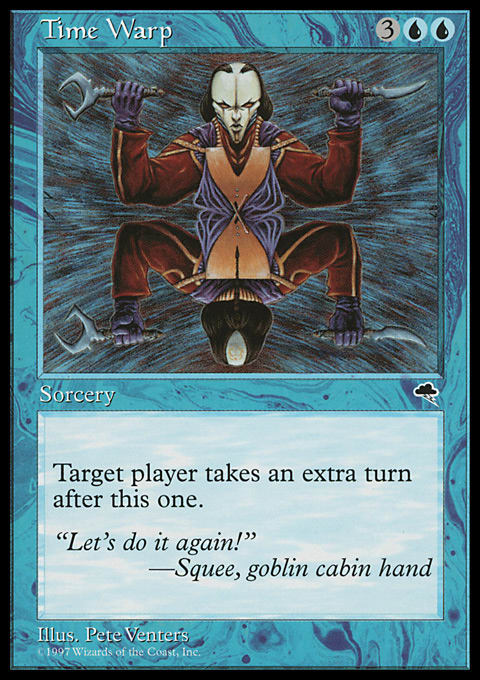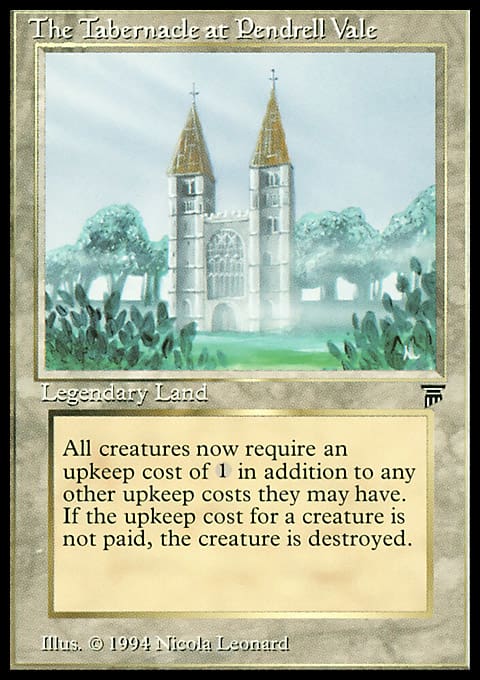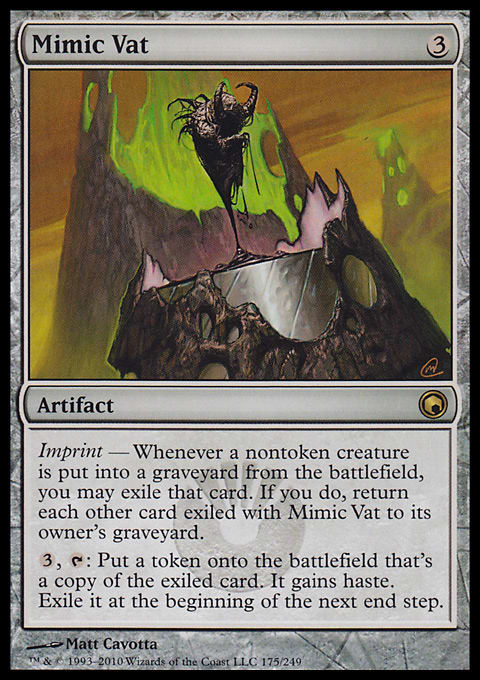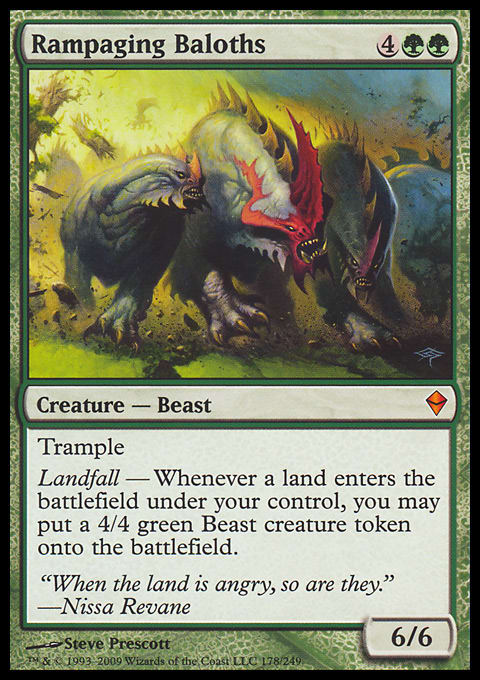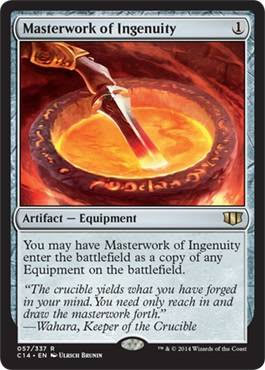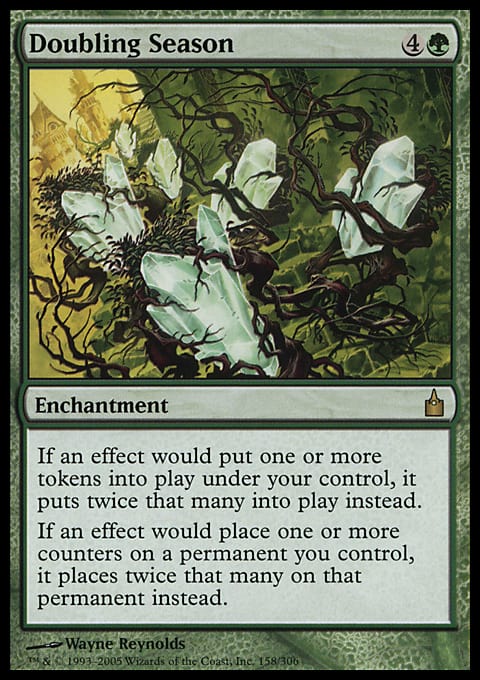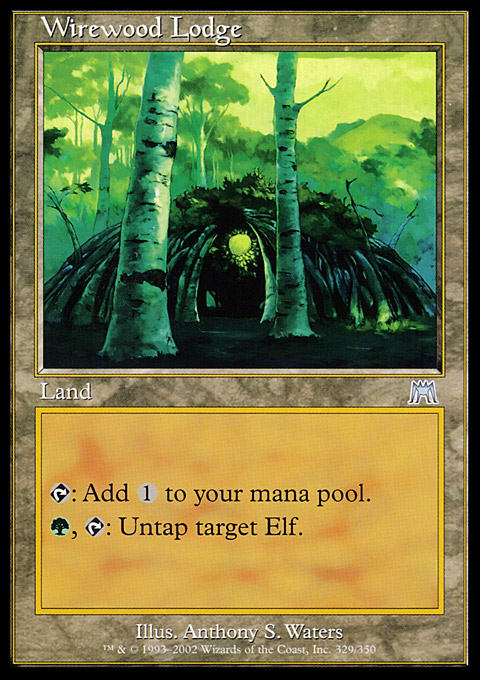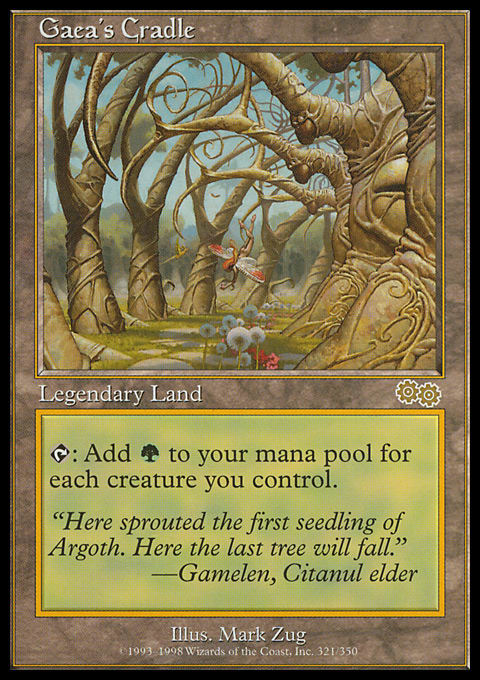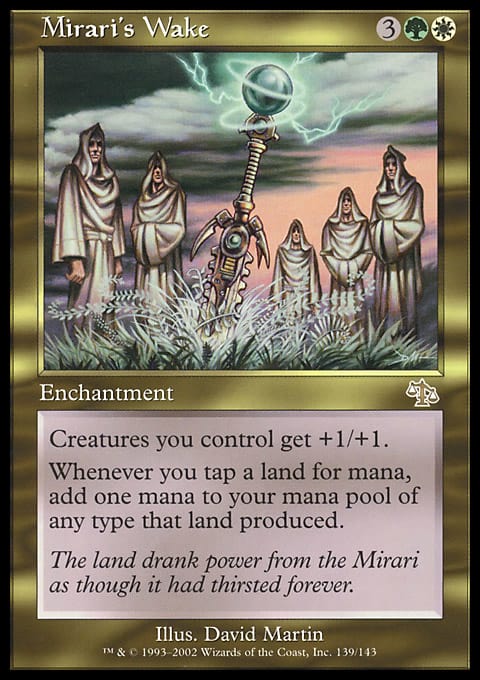Some people believe that fun is zero-sum. That is to say that any game or group is a closed system in which there is a finite amount of fun to be had. Consequently, if one person is having a lot of fun, it must be happening at the expense of someone else who is in that closed group. Here are a few examples I’ve seen cited that are pertinent to Magic: combo decks that take long turns, eating up most of the game time; prison decks that prevent people from playing their cards; and noninteractive strategies like Burn or Fog decks. Perhaps the most viscerally relatable example is the Time Warp strategy. These decks try to take as many sequential turns as possible, which allows them to do all kinds of crazy things while simultaneously denying any other players the opportunity to play.
On its face, this idea is pretty attractive. After all, it’s eminently understandable. We’ve all experienced that moment when your fifth spell is countered, when the board is swept for the third time, or when you sacrifice your last permanent to Smokestack—that moment when you can feel the fun draining away and you just don’t want to play that game anymore. Under this concept of zero-sum fun, it’s completely reasonable to assume that a deck, interaction, or card is just inherently unfun—and to blame a player or strategy for taking fun away from you.
I used to subscribe to this idea, but a couple of years of gaming and working with the Stybs has changed my perspective.
The first game I ever played with Adam was a heads-up game of Commander at Pro Tour Philadelphia in 2011: Child Lands squaring off against Rhys Tokens. The game started off exactly the way the Child of Alara deck scripts it. You sweep the board two or three times, tutor up The Tabernacle at Pendrell Vale, and set up a Strip Mine lock. Roundabout here is where most players decide they’re done with the game and never want to play against the deck again. Adam didn’t scoop up his cards. Not only that, but he stayed engaged and excited about the game, kept cracking jokes, and caught a mistake I made that eventually let him battle back to win. (Side note: I have yet to beat the Stybs in a game of Commander. Someday, Adam.) The lesson I took away from that game and every other game I’ve ever played with Adam is this:
We can be responsible for our own enjoyment of the game.
Sure, it’s unfortunate when you can’t do the things your deck is supposed to do. But there’s more going on than just what’s on the table. Sometimes, all it takes is a little table talk to salvage a game. Sometimes, it’s finding a cute interaction to try in one of your decks or another player bringing a card that you’ve never seen before. There’s all kinds of fun to be had when you sit down to play a game, and I’ve found that if you’re determined to have a good time when you sit down, there’s very little that anyone can do to stop you.
So as Adam moves on to new and exciting things, I want to put together a deck that celebrates the lessons he taught me out of game by putting my own spin on the classic Stybs archetype: G/W tokens. I’ve never seen Adam enjoy a game of Magic more than when he is able to rummage around in his box for the right token and start breaking out different-colored dice for +1/+1 counters versus number of tokens. Some of the craziest games I’ve ever played have been due in large part to some kind of token pandemonium, and I’m excited to see what kind of crazy things have become possible since the last time I tried.
Let’s start with the most important question:
Who’s the Commander?
There are a lot of good options in G/W, but I think it’s pretty easy to narrow it down. Karametra, God of Harvests is pretty exciting, but not very token-friendly. Tolsimir Wolfblood pumps tokens and brings Voja along, but ultimately, I don’t think he’s powerful enough for what I want to do. I’m looking at either Rhys the Redeemed or Trostani, Selesnya's Voice, mostly because they can copy all kinds of tokens, which means that there are some very interesting possibilities.
For this particular deck, I’m going to go with Trostani, largely due to the mana efficiency of his effect relative to Rhys. The deck will certainly play both legends, and I will definitely be giving them both an opportunity at the helm, but I’m building around being able to consistently and cheaply populate a plethora of crazy tokens.
What Things Do I Want to Populate?
If I’m going to be populating tokens, I don’t want to play with Soldiers and Saprolings. There are a number of really interesting ways to make some crazy tokens that can be much more powerful, even if you do have to do a little more work. What I’m looking at is trying to use the likes of Mimic Vat, Minion Reflector, Dual Nature, and Soul Foundry to make tokens that are copies of powerful creatures—and then populate them as quickly as possible to generate an overwhelming board presence.
Of course, the next question has to be what creatures are the best to populate. Given the opportunity to put anything in G/W under a Mimic Vat and start populating it, what are the absolute best targets? I’m thinking cards like Greenwarden of Murasa, Thunderfoot Baloth, Avenger of Zendikar, and Rampaging Baloths. If we can start populating cards like this, you can quickly start generating the kind of board position and card advantage that is almost impossible to overcome.
But Why Settle for One?
If the goal is to populate these gigantic value creatures as quickly as possible, we certainly can’t settle for one token per turn cycle. We can do much, much better than that. Let’s start by tossing Rings of Brighthearth and Illusionist's Bracers into the mix. Add a Stoneforge Mystic and Steelshaper's Gift for consistency and Masterwork of Ingenuity for redundancy, and suddenly, one Trostani activation is netting us quite a few tokens.
But once again, why settle for one token or one activation? Parallel Lives, Doubling Season, and Primal Vigor are things we can be doing, but what I really want are mechanisms of untapping Trostani. Wirewood Symbiote, Quirion Ranger, and Wirewood Lodge are great examples. Seedborn Muse is obviously absurd, but particularly powerful in this type of shell. Part of the reason these untap effects are so powerful is because they interact with things beyond just Trostani. Suddenly, Knight of the Reliquary and Yisan, the Wanderer Bard have increased utility, and our deck has additional engines beyond the Trostani-plus-tokens that our opponents have to fight over.
That Sounds Awfully Expensive
And it is. All these activations is part of why I opted for Trostani over Rhys. Trostani gives you less raw power, but more ability to maximize your mana on any given turn between various activations and untappings and whatnot.
The key to this strategy is going to be finding a way to generate enough mana to pay for everything all at once, and Gaea's Cradle has to be a big part of that. To that end, this deck is going to want some combination of Knight of the Reliquary, Expedition Map, and other nonbasic-land tutors to ensure access to Gaea's Cradle and potentially Deserted Temple. These nonbasic tutors also give you the ability to lean on Myriad Landscape and Krosan Verge in conjunction with Sun Titan or Titania, Protector of Argoth.
Realistically, though, that’s not going to be enough to get you up and running. Gaea's Cradle requires a base of tokens before it really becomes good, and you can’t just spend your turns activating Myriad Landscape over and over. We’re going to need some combination of mana creatures like Sakura-Tribe Elder and Yavimaya Granger that we can turn into tokens and populate, as well as Mirari's Wake and Mana Reflection as backups to Gaea's Cradle to make sure we can afford to pay for all of the activations.
So with all that in place, what does the tentative list look like? Take a look:
Trostani, Selesnya?s Voice ? Commander | Carlos Gutierrez
- Commander (0)
- Creatures (29)
- 1 Acidic Slime
- 1 Armada Wurm
- 1 Avenger of Zendikar
- 1 Dauntless Escort
- 1 Emeria Angel
- 1 Eternal Witness
- 1 Farhaven Elf
- 1 Greenwarden of Murasa
- 1 Hornet Queen
- 1 Karmic Guide
- 1 Knight of the Reliquary
- 1 Oracle of Mul Daya
- 1 Quirion Ranger
- 1 Rampaging Baloths
- 1 Regal Force
- 1 Restoration Angel
- 1 Sakura-Tribe Elder
- 1 Scavenging Ooze
- 1 Seedborn Muse
- 1 Stoneforge Mystic
- 1 Sun Titan
- 1 Thunderfoot Baloth
- 1 Wirewood Symbiote
- 1 Wood Elves
- 1 Yavimaya Granger
- 1 Nissa, Vastwood Seer
- 1 Rhys the Redeemed
- 1 Titania, Protector of Argoth
- 1 Yisan, the Wanderer Bard
- Planeswalkers (1)
- 1 Garruk Wildspeaker
- Spells (29)
- 1 Chord of Calling
- 1 Rootborn Defenses
- 1 Sundering Growth
- 1 Swords to Plowshares
- 1 Austere Command
- 1 Council's Judgment
- 1 Hour of Reckoning
- 1 Masterwork of Ingenuity
- 1 Steelshaper's Gift
- 1 Sylvan Scrying
- 1 Doubling Season
- 1 Dual Nature
- 1 Mana Reflection
- 1 Mirari's Wake
- 1 Parallel Lives
- 1 Quest for Renewal
- 1 Retreat to Emeria
- 1 Seance
- 1 Birthing Pod
- 1 Expedition Map
- 1 Illusionist's Bracers
- 1 Mimic Vat
- 1 Minion Reflector
- 1 Rings of Brighthearth
- 1 Skullclamp
- 1 Soul Foundry
- 1 Sword of Feast and Famine
- 1 Sword of Light and Shadow
- 1 Sword of the Animist
- Lands (40)
- 40 Lands
What I like about this deck is that it can do some of the most Timmy-tastic things I’ve ever tried to do. Populating Thunderfoot Baloth tokens to grow your team to monstrous proportions, Rampaging Baloths so that each land drop creates a small army, or just Hornet Queen to create an overwhelming squad of flyers to start taking to the skies. All of these cards are completely reasonable on their own, but let you become super-degenerate once the Trostani engine is up and running.
But here’s the thing: Even when this deck is going off and doing all the token craziness it’s capable of, it’s still just tokens. Beyond the Rootborn Defenses and Dauntless Escort, there’s not much protection from sweepers besides Karmic Guide, which means this deck is only as busted as people allow it to be. All the engines are absolutely disruptable, and all the key interaction occurs during the combat step; the deck is powerful and fun, but eminently fair.
Sure, the deck isn’t classic Stybs in the same way that Rhys doubling up a horde of Soldier tokens is, but I think it’s a nice compromise between Timmy-tastic token tendencies and my own more combo- and engine-oriented approach. There’s certainly some tweaking to be done, and I have yet to see if cards like Soul Foundry and Séance are even cards you can realistically play in Commander, but I’m excited to find out, and I’m sure I’ll have some serious fun, Stybs style, along the way.
















